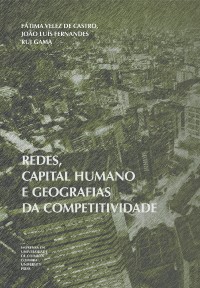Please use this identifier to cite or link to this item:
https://hdl.handle.net/10316.2/39066| DC Field | Value | Language |
|---|---|---|
| dc.contributor.author | Fanta Garrido, Javiera | |
| dc.date.accessioned | 2016-06-20T14:30:11Z | |
| dc.date.accessioned | 2020-09-08T18:40:10Z | - |
| dc.date.available | 2016-06-20T14:30:11Z | |
| dc.date.available | 2020-09-08T18:40:10Z | - |
| dc.date.issued | 2016 | - |
| dc.identifier.isbn | 978-989-26-1197-6 (PDF) | |
| dc.identifier.uri | https://hdl.handle.net/10316.2/39066 | - |
| dc.description.abstract | From the second half of the 20th century, Argentina has experienced the regionalization of its migratory flows, an increasing participation of women in human mobility and changes over the temporariness and destination of the immigration. These trends occur within a context where global capitalism - which sets the pull/push factors for migration - interacts with a network system between the place of origin and destination. The transnational dimension of these networks affects the behavior of migratory tendencies and the direction and temporariness of population displacements. The objective of this research is to study the performance of immigration and settlement patterns of foreign population in Argentina during the first decade of the 21st century, in accordance to some of the main migration networks developed in the previous decade. In particular, flows from neighboring countries of Bolivia, Peru and Paraguay are studied due to the volume of their stock. Data on migration trends were obtained from the Argentinean Population Census of 2001 and 2010, and from the National Migration Office database on residence permits issued between 2004 and 2011. Literature on the construction of migration networks and the Supplementary Survey of International Migration (2003) were analyzed. Results show a deepening of the migration profile registered in the decade of 1990 and that the settlement pattern that prevails within the foreign population between 2001 and 2010 is the urban‑‑long term residence, also influenced by the creation of certain migration networks. | eng |
| dc.description.abstract | Desde la segunda mitad del siglo 20, Argentina hay vivenciado la regionalización de sus flujos migratorios, una creciente participación de mujeres en la ovilidad humana y cambios en la transitoriedad y destino de la inmigración. Estas tendencias ocurren en un contexto donde el capitalismo global - lo cual define los factores de atracción/repulsa para la migración - interacciona con el sistema de red entre el lugar de origen y de destino La dimensión ransnacional de esas redes afecta el comportamiento de las tendencias migratorias y la dirección y transitoriedad de las dislocaciones de populación. El objetivo de esta pesquisa es estudiar desempeño de los padrones de inmigración y fijación de población extranjera en Argentina durante la primera década del siglo 21, de acuerdo con algunos de los principales sistemas migratorios desarrollados en la década anterior. En particular, flujos de los países vecinos Bolivia, Perú y Paraguay son estudiados debido al volumen de su stock. Datos sobre tendencias de migración fueran obtenidos de los Censos de Población Argentina y de la base de datos de la Oficina Nacional de Migración sobre visas de residencia emitidos entre y 2004 y 2011. Ha sido analizada literatura sobre la construcción de redes de migración y la Encuesta Suplementario Internacional de Migración (2003). Los resultados demuestran una profundización del perfil de inmigración registrado en la década de 1990 y que los padrones de fijación que prevalecen en la población extranjera entre 2001 y 2010 es la residencia urbana de larga duración, también influenciado por la creación de ciertas redes de migración. | por |
| dc.language.iso | spa | - |
| dc.publisher | Imprensa da Universidade de Coimbra | por |
| dc.relation.ispartof | http://hdl.handle.net/10316.2/39064 | por |
| dc.rights | open access | - |
| dc.subject | Transnationalism | eng |
| dc.subject | migration networks | eng |
| dc.subject | settlement patterns | eng |
| dc.subject | temporariness | eng |
| dc.subject | border migration | eng |
| dc.subject | Transnacionalidad | por |
| dc.subject | redes de migración | por |
| dc.subject | padrones de fijación | por |
| dc.subject | transitoriedad | por |
| dc.subject | migración de frontera | por |
| dc.title | Argentina, 2001-2010: tendencias recientes de la migración internacional e influencia de las redes migratorias sobre los patrones de asentamiento de los migrantes | por |
| dc.title.alternative | Argentina, 2001-2010: international migration trends and influence of the migratory networks on the settlement patterns of immigrants Javiera | eng |
| dc.type | bookPart | por |
| uc.publication.collection | Geografias | por |
| uc.publication.firstPage | 39 | - |
| uc.publication.lastPage | 80 | - |
| uc.publication.location | Coimbra | por |
| dc.identifier.doi | 10.14195/978-989-26-1197-6_2 | - |
| uc.publication.digCollection | PB | por |
| uc.publication.orderno | 2 | - |
| uc.publication.area | Ciências Sociais | por |
| uc.publication.bookTitle | Redes, capital humano e geografias da competitividade | - |
| uc.publication.manifest | https://dl.uc.pt/json/iiif/10316.2/39066/206042/manifest?manifest=/json/iiif/10316.2/39066/206042/manifest | - |
| uc.publication.thumbnail | https://dl.uc.pt/retrieve/11091899 | - |
| uc.publication.parentItemId | 54629 | - |
| uc.itemId | 69224 | - |
| item.fulltext | With Fulltext | - |
| item.grantfulltext | open | - |
| Appears in Collections: | Redes, capital humano e geografias da competitividade | |
Files in This Item:
| File | Description | Size | Format | |
|---|---|---|---|---|
| argentina_2001-2010.pdf | 3.01 MB | Adobe PDF |  |
Items in DSpace are protected by copyright, with all rights reserved, unless otherwise indicated.
